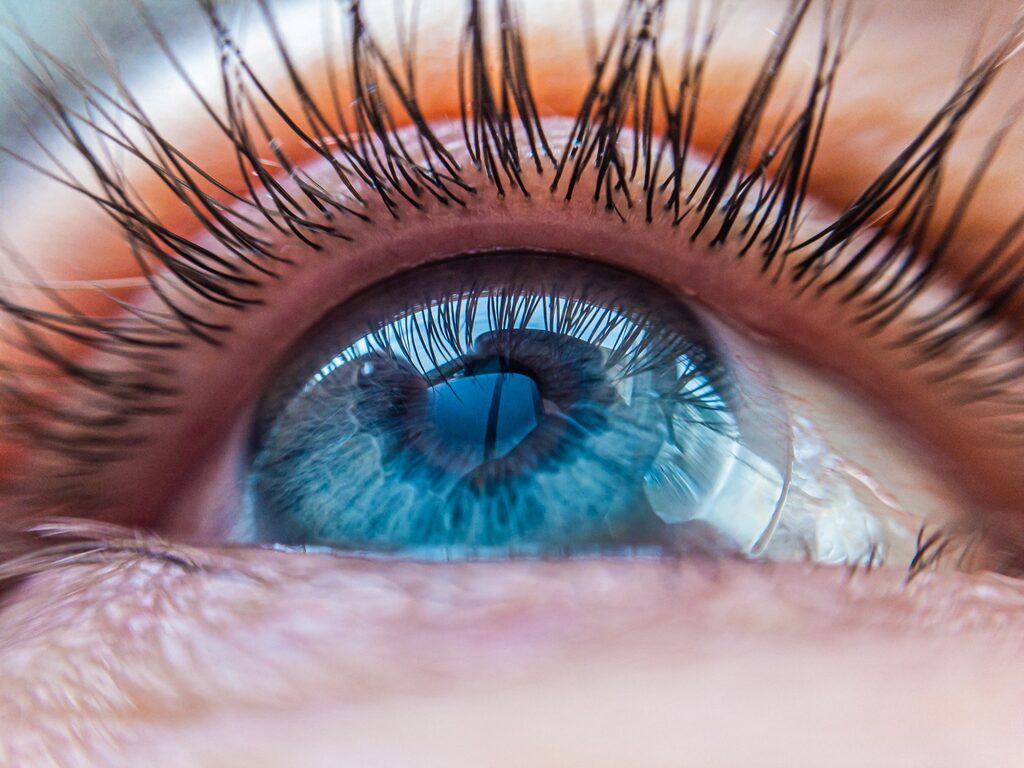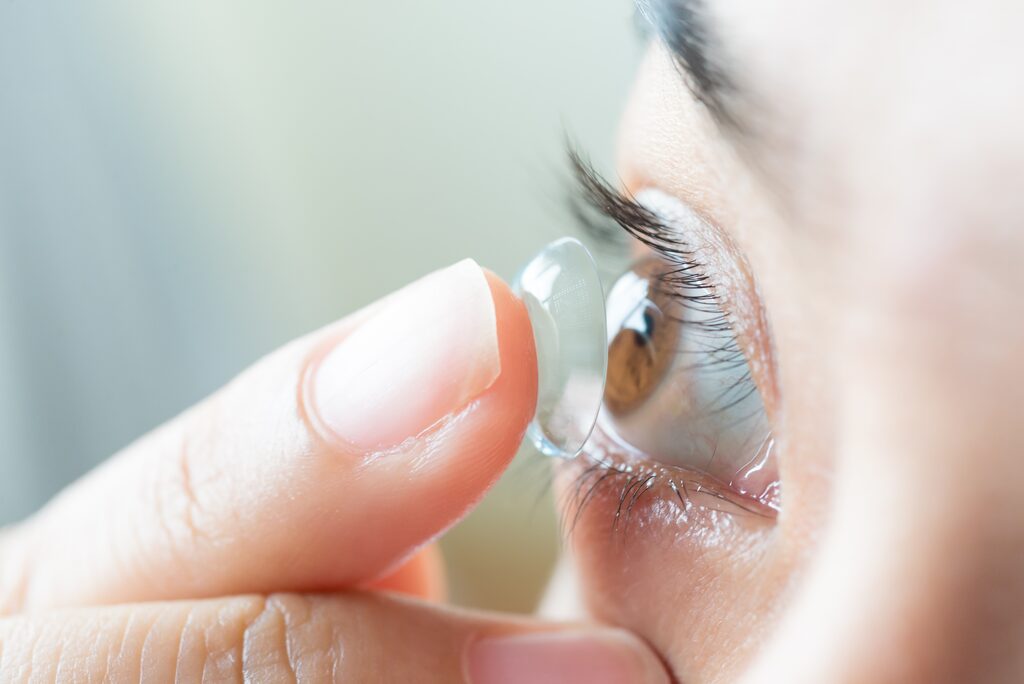Dr. Sven Lee's Oculight® practice offers preventive care, examinations, treatments and individual consultations on the following topics, among others:

Cataract
Many people initially perceive the symptoms of cataracts as if they were wearing glasses that are too weak. In the course of this eye disease, those affected have the impression of permanently seeing through a gray fog. One should investigate whether a cataract is present if the visual acuity decreases while less contrasts are recognized. Also, if you are more easily dazzled and see colors paler (especially if many things appear more yellow or brown than before), a clarification regarding cataract in our ophthalmologic practice is worthwhile. After all, there can be many reasons for the development of a cataract, from long-term smoking and UV exposure, diabetes, certain medications or concurrent glaucoma, to advanced age (over 60) or injuries experienced. In some cases, the condition exists from birth.
Cataract is also known as cataract. Characteristic is the clouding of the eye lens. Since this is not homogeneous, the opacity can take different forms: The lens cortex, capsule or nucleus can be affected or even all parts of the lens. Age-related cataract usually progresses slowly. If a disease or injury is the cause, the cataract can progress rapidly. During cataract surgery, the cloudy lens is removed and replaced with a permanent, artificial lens.
Today, there are different types of lenses to choose from for this - together we will find the optimal one for you. For early complete visual rehabilitation, lens replacement is often already performed in the case of major refractive errors caused by the opacity. Feel free to contact our practice for cataract diagnosis and treatment if you observe symptoms.

Cataract - Glaucoma
Glaucoma occurs in all age groups, but more frequently in people over 40. Since the disease usually begins insidiously and painlessly, it is unfortunately often only noticed when there is already major damage to the optic nerve. This initially affects the visual field and becomes more serious over time until central vision is ultimately impaired. In untreated glaucoma, visual acuity decreases until blindness of the respective eye occurs. In rare cases, a glaucoma attack occurs: such a sudden increase in eye pressure is noticeable by headaches, nausea and blurred vision. The term glaucoma covers several diseases of the optic nerve that lead to a loss of nerve fibers. In some forms of glaucoma, the eye pressure remains normal, so it must be diagnosed accurately.
The eye produces so-called aqueous humor to supply the cornea and lens with nutrients. Once this is used up, it must be able to drain away so as not to increase the eye pressure. After an appropriate diagnosis, we can surgically create an additional artificial drainage path for the aqueous humor. In many cases, lowering the pressure with eye drops is sufficient to treat glaucoma.
Various examinations are available for the diagnosis of glaucoma. In addition to eye pressure measurement (tonometry), these include optic disc assessment (ophthalmoscopy), visual field measurement (perimetry) and chamber angle assessment (gonioscopy). In some cases, we also perform retinal measurements.
Especially when risk factors such as circulatory dysregulation or diabetes exist, a preventive examination is worthwhile.

Refractive surgery
Refractive surgery can be used to treat refractive errors. The term summarizes eye surgeries that change the overall refractive power of the eye. Successful refractive surgery replaces glasses or contact lenses or significantly reduces their strength. Lasers are used in most refractive treatments because the odds with this procedure are easy to predict, while the side effects are few. The ASA LASEK surgical method, co-developed by Dr. Sven Lee, not only corrects low to moderate refractive errors. It can also treat various presbyopia, nearsightedness of up to -15 diopters, astigmatism of up to -6 diopters, night vision problems and severe farsightedness by superficially deforming the cornea.
The surgical procedure LASEK (Laser Epithelial Keratomileusis) has been developed from PRK (Photorefractive Keratectomy), which has been tried and tested for 25 years. Trans-PRK (Transepithial Photorefractive Keratectomy), in turn, is an alternative to PRK and PRK/LASEK laser eye correction. To avoid all foreseeable risks, every laser surgery is preceded by a careful preliminary examination.
The experience of the surgeon, the amount of correction desired, the device used, and the patient's personal disposition, among other factors, all play a role in the success of the treatment. Our surgical standards are regularly monitored. In particular, the quality assurance guidelines of the Refractive Surgery Commission are taken into account.
In our practice, Dr. Sven Lee, as an experienced surgeon, uses a state-of-the-art excimer laser of the TENEO(TM) 317 brand.

Presbyopia
In most people, the ability of the lens of the eye to deform decreases over the course of life. From around the mid-40s, many people are therefore no longer able to see as well at close range. This is noticeable, for example, when you have to hold the newspaper further away to read than before. Usually, presbyopia does not worsen after the age of 65. To take a medical history of so-called presbyopia, we perform various measurements to find out the cause of the blurred vision and then initiate a tailor-made treatment. In many cases, this involves reading glasses, bifocals or varifocals. If myopia is also present, contact lenses may also be considered. Depending on individual factors, laser treatment may be useful for correcting presbyopia.
Another treatment option for presbyopia is the surgical use of a multifocal plastic lens. This is particularly recommended if there is additional lens opacity or corneal curvature. Sometimes, as an alternative, a corneal implant made of plastic is inserted into the non-dominant eye to increase the depth of focus so that it can be used as a "reading eye".
In our practice in Eschborn, we reliably diagnose any presbyopia and then advise you on the various treatment options. We will help you choose the optimal visual aid so that you can read for longer periods of time in the future, even when you are tired or in poor light, without developing headaches due to the strenuous focusing of the aged eye lens.
Also, keep in mind that diseases such as diabetes or multiple sclerosis can promote earlier presbyopia.

Ophthalmic precaution
By means of early detection examinations in our ophthalmology practice, you can ensure that your or your child's vision remains at its full potential for longer. Nowadays, many eye diseases can be detected in time and often treated well. Important and frequently performed screenings relate to glaucoma, cataracts, macular degeneration and retinal diagnostics. Many age-related diseases of the visual apparatus do not yet cause noticeable symptoms, but should be treated early to prevent late effects. Ophthalmologic screening for a child is appropriate because guardians often cannot detect eye disease by the child's behavior alone. Preventive eye care visits are especially recommended when a parent has an eye condition.
The eyes are one of the most important sensory organs. They are used almost constantly in everyday life and at the same time they are very sensitive. In addition to early detection appointments in childhood, preventive eye care appointments are therefore recommended from the age of 40, especially for vehicle drivers. Basic preventive care includes general checks of visual acuity and color and contrast perception.
An annual eye examination for early glaucoma detection is recommended for people with a family history of glaucoma from the age of 30. From the age of 60, regular AMD screening is also recommended to prevent gradual deterioration of vision. This involves checking the function of the center of the retina (macula).
Other preventive measures include measuring the thickness of the cornea and nerve fiber layer, or a reflection of the back of the eye.

Custom contact lenses
To ensure that wearing contact lenses feels good for a long time, a professional fitting in an eye care center is important. At Oculight, we first find out whether your eyes are basically suitable for contact lenses. In addition, we discuss which contact lens system meets your needs (and those of your eyes). As a result, you will receive a contact lens that is as unique as your eyes. These individual lenses are made specifically for your eyes based on an exact measurement, so that they will always be sufficiently supplied with oxygen in the future. Accordingly, they can remain healthy in the long term, even with long periods of wear. Custom-made individual contact lenses therefore have a high biological compatibility. For optimal fitting of contact lenses we work with modern computer-assisted procedures of the latest technology.
In principle, almost all refractive errors can be corrected with contact lenses. A distinction is made between soft and dimensionally stable contact lenses. These are available in various designs. Among them are daily, monthly and annual lenses, but also multifocal contact lenses for presbyopia as well as toric lenses for astigmatism and other special lenses, on which we advise you.
Examples of special lenses are contact lenses for keratoconus (corneal disease), lenses for people with transplanted corneas and lenses for the disease aphakia (lenslessness). Likewise, special contact lenses are needed if you suffer from achromatopsia (color blindness) or if your eyes have been affected by injury or inflammation/infection.
For the health of your eyes, in addition to contact lens fitting, care and regular follow-ups are important.

Trans-PRK

Lasek
LASEK (Laser Epithelial Keratomileusis) is an advanced procedure in eye surgery for the correction of visual defects such as myopia (nearsightedness), hyperopia (farsightedness) and astigmatism (astigmatism). It is based on the advancement of PRK (photorefractive keratectomy) and is similar to LASIK (laser in situ keratomileusis).
The LASEK procedure begins with preparation, in which the surgeon carefully lifts or removes the top layer of the cornea (epithelium) to gain access to the underlying tissue. An excimer laser is then used to precisely reshape the tissue beneath the epithelial layer. The cornea is flattened for nearsightedness, curved for farsightedness and irregularities are corrected for astigmatism. After laser treatment, the epithelium is carefully laid back and a protective lens is placed to aid healing. Compared to LASIK, LASEK does not involve cutting corneal flaps, which maintains corneal stability.
LASEK offers certain benefits for patients with thin corneas or an increased risk of complications. However, recovery time may be slightly longer than LASIK because the epithelial layer needs time to fully regenerate. Although LASEK is a safe and effective method of vision correction, a thorough preliminary examination by an experienced eye surgeon is essential to determine if the procedure is appropriate for the individual patient. Overall, LASEK allows many people to achieve significantly improved vision without glasses or contact lenses.

ASA-Lasek
ASA-LASEK (Advanced Surface Ablation - Laser Epithelial Keratomileusis) and PTK (Phototherapeutic Keratectomy) are special procedures in ophthalmic surgery used to treat various corneal diseases and visual defects. ASA-LASEK is a further development of LASEK and PRK.
It involves carefully removing the top layer of the cornea (epithelium) to gain access to the underlying tissue. An excimer laser is then used to reshape the tissue and correct visual defects such as nearsightedness, farsightedness and astigmatism. By not cutting a corneal flap, as is the case with LASIK, the stability of the cornea is maintained. PTK, on the other hand, is a procedure used specifically to treat corneal conditions such as dystrophic changes or scarring. The excimer laser is used to remove precise and controlled layers of tissue from the cornea to smooth the surface or correct irregularities.
Both procedures, ASA-LASEK and PTK, are appropriate for patients for whom LASIK is not recommended due to thin corneas, unstable eyes or other medical concerns. Recovery time for ASA-LASEK and PTK is typically slightly longer than LASIK because the top layer of the cornea must heal.
A comprehensive preliminary examination by an experienced eye surgeon is critical to determine which procedure is best for the individual case. Overall, ASA-LASEK and PTK allow many people to enjoy improved vision quality and help them lead active and comfortable lives without constant dependence on glasses or contact lenses.
Book your personal appointment at the Oculight® practice and learn which treatments can improve your vision.